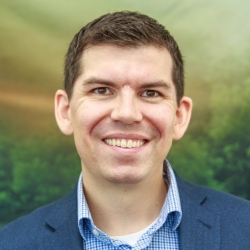NORMAN, OKLA. – A University of Oklahoma researcher, Scott Salesky, leads a project funded by a half-a-million-dollar grant from the Department of Energy to improve climate modeling. This research project is one of several funded through a $15.6 million initiative by the DOE for new research that aims to improve scientists’ ability to accurately predict weather and climate patterns.
“We are very proud of Professor Salesky and his important new research, which will be funded by the Department of Energy,” said Berrien Moore, dean of the College of Atmospheric and Geographic Sciences and director of the National Weather Center. “Professor Salesky will be advancing our knowledge of the dynamics of the lower atmosphere, which is critical for large-scale weather patterns, including the formation of severe weather.”
Salesky, an assistant professor of meteorology in the OU College of Atmospheric and Geographic Sciences, says his project applies the principles of fluid dynamics common in engineering to the study of turbulent transport, or the exchange of heat, moisture and momentum, in the lower atmosphere with the Earth’s surface.
“Like the airflow over an airplane wing, with weather patterns, you can get some very large-scale organization – streaks of high- and low-speed fluid next to each in the atmosphere – which have been shown to play a really important role in the turbulent transport in these flows,” Salesky said. “The question that we’ve been trying to answer is ‘what happens in the lower atmosphere?’"



